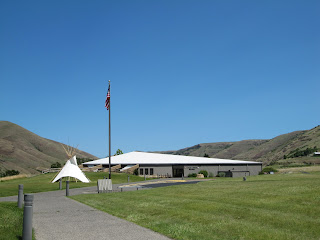For centuries, natives fished the river, preserving the
salmon through smoking or drying processes. Early Europeans tried salting and
packing salmon in barrels which were shipped to Hawaii and the East Coast with
mixed results. However, improvements in canning methods meant the fish could be
packed safely and travel all over the world.
The Hume brothers opened the first salmon cannery in 1866 in Eagle
Cliff, Washington, a few miles upstream from present day Cathlamet. Their
success spawned the development of more canneries along the lower Columbia
River, and by the heyday of the late 1880s, there were 38 canneries in the
area, packing as much as 30 million, one-pound cans a year. That’s a lot of
potential salmon patties.
 |
| Pier 39, Astoria |
The canneries brought jobs to the area along with a rich mix
of ethnic groups whose cultures and influence have remained. In the early days, much of the dirty work of
butchering salmon was done by Chinese men supplied by labor contractors out of
San Francisco. With the Chinese
Exclusion Act of 1882, canneries turned to Filipinos and Japanese workers,
while at the same time immigrants from Scandinavia, Finland, Yugoslavia and the
Mediterranean arrived to fish and labor in the canneries.
 |
| Inside the Bumble Bee Museum |
Astoria, Oregon, was the center of the canning business
and carried the moniker, Cannery Capital of the World. Once home to 22
canneries, it’s a good place to begin a tour of what remains of this important
industry. Nearly all the wooden cannery
buildings have succumbed to old age and blustery winter storms, but a few
remain in Astoria. At the end of 39th St. on the eastern end of town
is Pier 39, the old Hanthorn/Bumble Bee Cannery. It was the last operating cannery in the
area, closing in 1980. Today it houses a coffee shop, pub, and the free Bumble
Bee museum. Inside are wooden gill-netter boats, old cannery processing
equipment, and photos of the days when Bumble Bee was Astoria’s largest
employer.
 |
| Big Red, Astoria |
Nearby, at the end of 31st St., is a large,
hulking, red building sitting out in the river and looking a bit tattered.
Known as Big Red, it served as a satellite station for Union Fishermen’s Coop
where fishermen could drop off their catch and spread their nets to dry. Over
100 years old, the wooden structure lost its top story in a wind storm in 2007,
but efforts are underway to save this piece of history.
Cross the Astoria-Megler Bridge to the Washington side of
the river and follow Hwy 401 east to Knappton Cove. Rotting wooden posts
extending out into the water are all that remain of the Eureka and Epicure Packing
Co. In 1899, the federal government built a quarantine station on the site of
the abandoned cannery. Ships arriving in Astoria were inspected for any signs
of contagious diseases. If infected, they were directed across the river to the
quarantine station, or pest house. Ships
were fumigated with burning sulfur and passengers treated for disease. Today
the building houses a museum open on Saturdays during summer months.
 |
| Knappton Cove Quarantine Station |
 |
| Altoona, Washington |
A bit further east, a winding road leads south from
Rosburg to the ghost town of Altoona. A few houses and wooden pilings in the
river are all that remain of a town that was once a major port for steamers
traveling between Portland and Astoria. This stretch of the river had six
canneries in the early 1900s, but today it is a quiet spot in a beautiful
setting. Large rock pillars topped with
hemlocks sit in the harbor, and the end-of-the-road atmosphere makes it well
worth the 13-mile, round-trip detour.
In the town of Cathlamet along the riverfront, a little
upstream from the boarded-up Water Rat Tap Tavern, is what remains of the
Warren Cannery. Two years ago, a large part of the building collapsed and today
what little remains is being salvaged. Once gone, it will join its fellow ghost
canneries along the lower Columbia.
 |
| Remnants of the Warren Cannery, Cathlamet |








